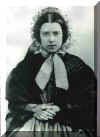


|
|
|
IntroductionThis section will look at the period of old photographs and look for dating evidence from them. The Information is derived from the following books:
Many of the photographs, where a photographer is named, can be identified in the directory above allowing accurate dating. Please contact the webmaster for details.
Types of PhotographsThere are number of types of old photographs we can come across during family history research. These are:
Cost of PhotographsAn idea of the costs of photographs can be found in the Abbey Street Sunday Schools book page 94 . This shows Pitt & Sons advertisement of about 1890. Costs were:
The Ambrotypes were the first photographs to be used with the rise of the commercial photographer. These were produced from an underexposed glass negative which was then covered with a backing of black velvet or shellac. A positive effect was then created . Originally known in Britain as collodion positives they were better known by their American name of Ambrotypes. Pictures are normally clear and sharp and when moved under light they can be seen to revert to their negative effect. Some cosmetic touch ups were performed on items such as jewellery using a gilding effect. Often the backing can fall away or mould get in between the original glass and a protective cover. These photos are often framed or cased. The Carte Visite was originally intended as just that, a visiting card. Made popular in England by Victoria and Albert, many photographs were shot in one sitting and there was a craze called Cartemania with people collecting and swapping cards of the famous, showing that Pokemon isn't a recent fashion. Some of these photographs may be included in your collections so, if you see Queen Victoria next door to Great great Auntie Flo, it doesn't mean that she came around for tea or that you are related, sorry about that. The picture are normally about 3.5" x 2.25" and is added to the photographers trade card of about 4" x 2.5". The Cabinet Print was a larger size, introduced in about 1866. These are similar to Carte Visite but are larger around about 4" x 5.5" and mounted on a trade card of about 4.5" x 6.5". Tintypes were the cheapest and quite popular form of photographs. These are produced on a very thin sheet of Iron and so you can check whether you have a tintype by tapping the photograph and seeing if it is paper or iron. Images are reversed and are often of poorer quality. These are frequently small, often 1.5" x 2.5" and slipped into a paper mount to bring them up to size for inserting in to an album. Tintypes were more often than not the tool of the travelling photographer rather than a studio based one. Novelties include shaped photographs and also those of unusual dimensions, i.e. tall and thin photographs. Very few are likely to survive as family portraits. Often novelty materials were used for the picture, glass, porcelain, wood and cloth. Stereos provided the viewer with a three dimensional view of the picture. These were at their peak in the 1850s and 1860s. It is unlikely that family portraits were taken using this technology but normally subjects such as Natural History and Architecture were recorded. The Postcard was a late Victorian to early Edwardian innovation when it became possible to send these through the post. Often collected the Postcard is still used today. We are familiar with the Postcard from the seaside but many did contain pictures of our ancestors. No doubt these were not always sent through the post but rather, stuck straight into the album.
Dating Old PhotographsIt would probably take up most of the space on this web site and do an injustice to Robert Pols if I were to produce the information on how to date old photographs here. What I can offer to do is to look at one of your particular photographs and see if I can provide an accurate date from the data in the two books mentioned above. There are various means to date photographs including the type (see above), the photographer, the dress and fashion(s) of the day and the backgrounds and subject posture. Let me know if you would like to undertake this sort of research?
|
|
|